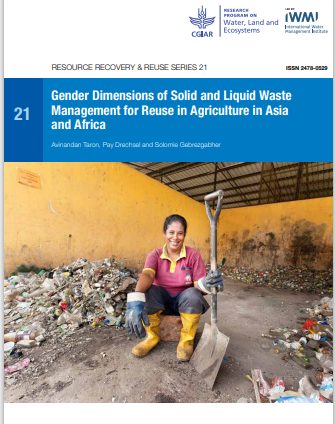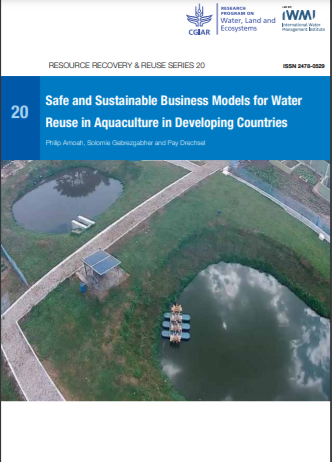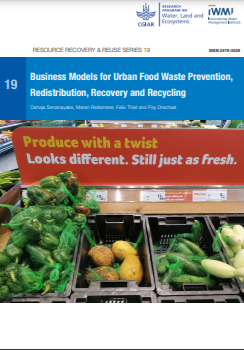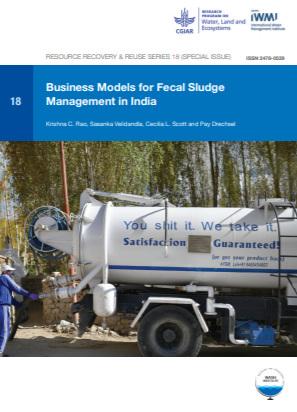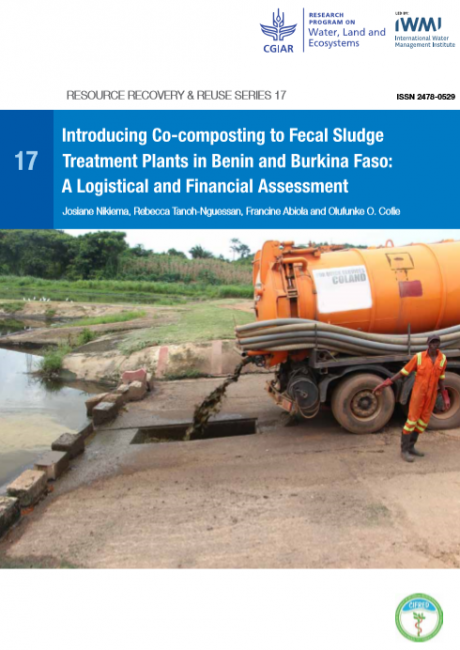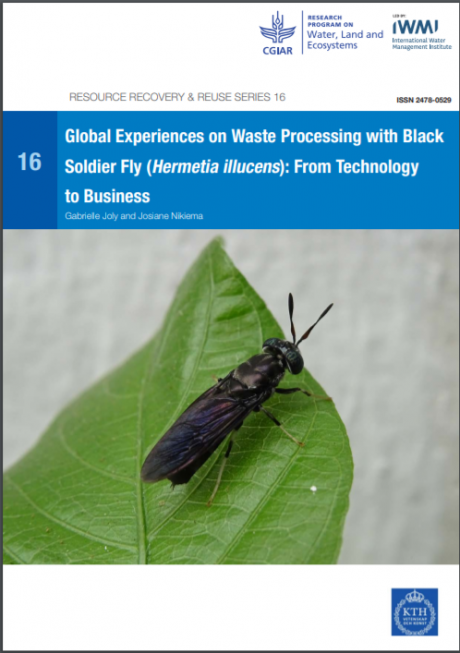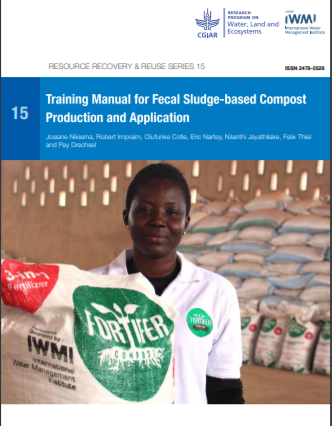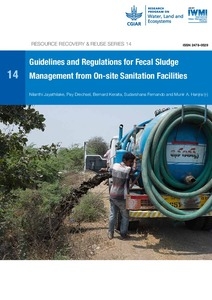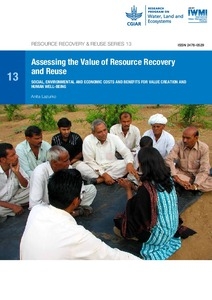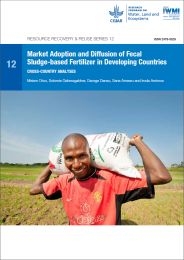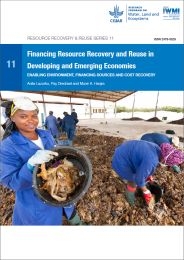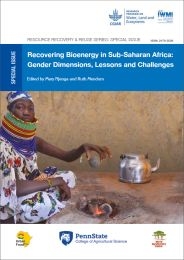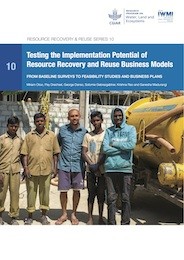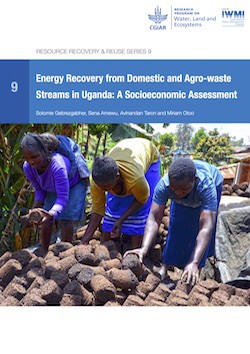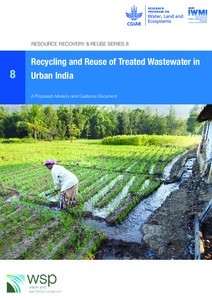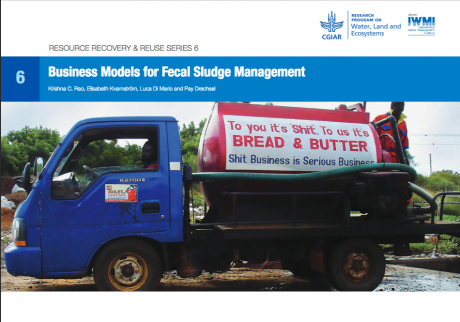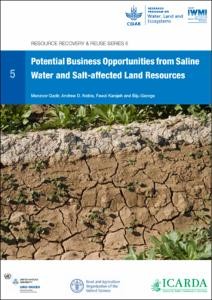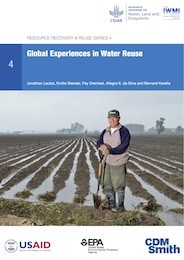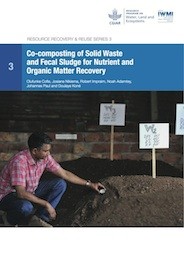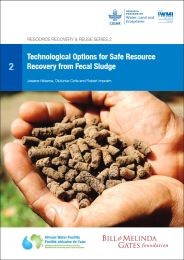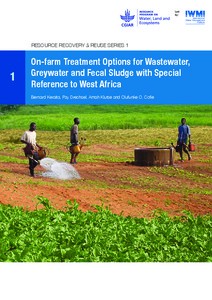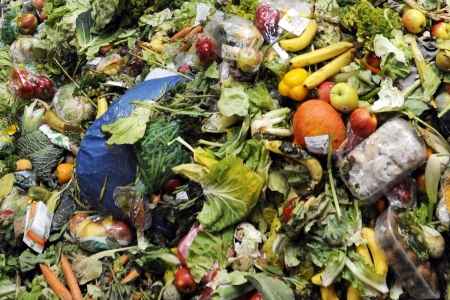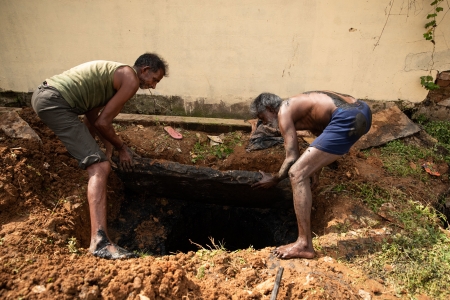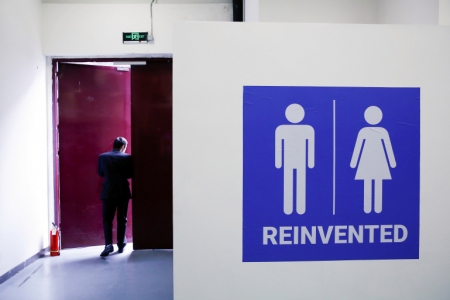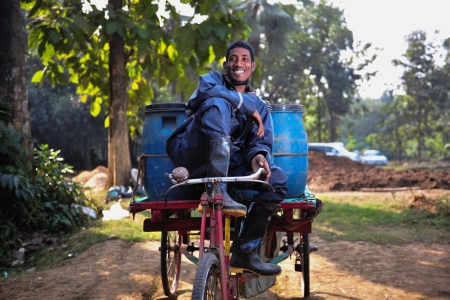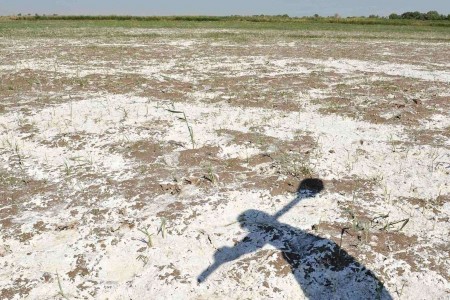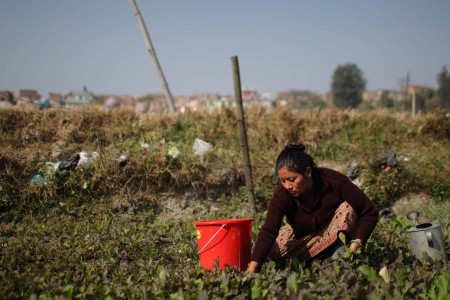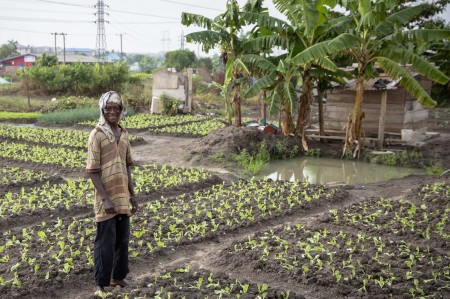The Resource Recovery and Reuse publication series and its publisher, the International Water Management Institute (IWMI) acknowledge the Committee on Publication Ethics (COPE) recommended Code of Conduct. Please refer to our statement on Publication Ethics and Publication Malpractice.
21. Gender dimensions of solid and liquid waste management for reuse in agriculture in Asia and Africa
This report examines social equality aspects related to resource recovery through solid waste composting and wastewater irrigation. The report shows that women are represented in greatest numbers at the base of the recycling chain, most often as informal waste pickers and as sorters of recyclables with limited access to resources and upward mobility. Despite a wide gender gap in the solid waste and sanitation sectors, women play a key role in both municipal waste reduction and food safety where irrigation water is unsafe. Analyzing the gender dimension is important for understanding household responses to recycling programs, differences between the formal and informal sectors as well as along the waste-to-resource value chain from collection to treatment and reuse. The report stresses the important role of women in household waste management, including waste segregation, and the power of women-dominated waste picker associations, where the informal sector plays an essential role alongside the formal sector. Read on.
20. Safe and sustainable business models for water reuse for aquaculture in developing countries
Wastewater-fed aquaculture has a long history, especially in Asia. This report examines three empirical cases of integrated wastewater treatment and aquaculture production. From an aquaculture entrepreneur’s perspective, the combination of fish farming and wastewater treatment in common waste stabilization ponds allows significant savings on capital (pond infrastructure) and running costs (wastewater supporting fish feed). On the other hand, the treatment plant owner will have the benefit of a partner taking over plant maintenance. Given the importance of food safety and related perceptions, the report is focusing on innovative business models where the marketed fish is not in direct contact with the treated wastewater, but only the brood stock or fish feed. The financial analysis of the presented systems shows profitable options for the fish farmer, operational and in part capital cost recovery for the treatment plant, and as the treatment plant operators can stop charging households a sanitation fee, eventually a triple-win situation for both partners and the served community. Read on.
19. Business models for urban food waste prevention, redistribution, recovery and recycling
A necessary extension of the concept of Resource Recovery and Reuse with an even higher priority is the prevention and reduction of waste. One concern, in particular, is food waste, which constitutes the largest share of human waste. Target 12.3 of the United Nations Sustainable Development Goals (SDGs) is to ‘halve per capita global food waste at the retail and consumer levels and reduce food losses along production and supply chains, including post-harvest losses, by 2030’. For this report, over 400 businesses were analyzed to identify common approaches and business models to address the food waste challenge. The business models are presented under seven categories – measurement, redistribution, resell, value addition, responsible waste collection, resource recovery, and recycling – with a special focus on their application potential to the Global South. Read on.
18. Business models for fecal sludge management in India
Globally, 50% of the population relies on on-site sanitation systems (OSS) such as septic tanks and pit latrines and is, hence, in need of Fecal Sludge Management (FSM) solutions. India is a classic example, given that its government built more than 100 million toilets with the majority relying on OSS. With 400 fecal sludge treatment plants (FSTPs) in various stages of planning, procurement and construction, this report comes at an opportune time to present findings on FSM business models already implemented across India. Read on.
17. Introducing co-composting to fecal sludge treatment plants in Benin and Burkina Faso: A logistical and financial assessment
Based on primary data from fecal sludge (FS) treatment plants in three West African urban regions (Ouagadougou in Burkina Faso, Greater Accra in Ghana, and Grand Nokoué in Benin), FS collection and treatment patterns were analyzed to identify possible scenarios for resource recovery (RR) through FS co-composting. FS collection was analyzed for up to 7 years, in part per day, month and season, as well as FS characteristics to understand peak flows, FS qualities and related variations to plan for appropriate RR technology and capacities.
Overall, the FS volumes collected by vacuum trucks were not significantly affected by the calendar days, months or seasons. Commonly assumed increases during rainy months were, for example, only recorded in Ouagadougou. FS composition appeared highly variable with a pronounced difference in total solids between FS collected from households versus institutional sources, likely indicating that institutions are served more frequently.
The analyzed treatment plants appear to be exploited beyond their capacity. RR for reuse can turn sludge disposal from a cost into a source of revenue with co-benefits for farmers and the environment, thereby reducing the pressure on tipping fees. The probability of the added co-compost production being financially viable on its own was estimated for all the study sites, indicating an earliest breakeven point after 5 to 8 years. Read on.
16. Global experiences on waste processing with Black Soldier Fly (Hermetia illucens): From technology to business
Black soldier fly colonies can produce about 100 times more protein per year than chicken or soybeans, not to mention cattle, on the same area of land. The flies can directly feed on different types of organic wastes, leapfrogging closed loop processes within a circular food economy. Also, where no protein is needed, for example, to feed fish or pigs, the larvae can be processed into high-quality biodiesel. However, can this be done at scale? The answer is ‘Yes’. The report showcases some of the leading global businesses in Black Soldier Fly production. Read on.
15. Training manual for fecal sludge-based compost production and application
Over the last decade, the International Water Management Institute (IWMI) has explored the use of fecal sludge (FS) in combination with other organic waste sources to optimize FS treatment and composting for the production of a safe organic fertilizer, which can – depending on demand – be enriched with crop nutrients or pelletized for volume reduction, delayed decomposition or easier application. Based on IWMI’s experience, this training manual has been compiled for plant managers and trainers to help ensure that staff involved in FS treatment and production, and application of an FS-based co-compost adopt best practices in all processes involved. The manual can be adapted to local needs as required. It also includes information on compost registration and certification, as well as guidelines for co-compost application in the field. Read On.
14. Guidelines and regulations for fecal sludge management from on-site sanitation facilities
In low- and middle-income countries, the management of fecal sludge from on-site sanitation systems has received little attention over many decades, resulting in insufficient or missing regulations to guide investments and management options. To address this gap, this report examines existing and emerging guidelines and regulations for fecal sludge management (FSM) along the sanitation service chain (user interface, containment, emptying, transport, treatment, valorization, reuse or disposal). It also draws empirical examples from guidelines across the globe to support policy-makers, planners, and sanitation and health officers, as well as consultants in low- and middle-income countries in the development and design of local and national FSM guidelines and regulations. Read on.
13: Assessing the value of resource recovery and reuse: social, environmental and economic costs and benefits for value creation and human well-being
To understand the full value of Resource Recovery and Reuse (RRR), a systematic assessment approach that balances complexity with practicality is required. This report highlights the methods available for quantifying and valuing social, environmental and economic costs and benefits of RRR, focusing on Cost-Benefit Analysis (CBA) as the primary framework. Rather than prescribing a standardized technique for conducting CBA for RRR, this report presents broad frameworks and several examples that can be catered to individual contexts. This results in a suggested eight-step process accompanied with suggested assessment techniques which have to be tailored to the type of question the assessment is meant to answer and related system boundaries. Read on.
12: Market adoption and diffusion of fecal sludge-based fertilizer in developing countries: cross-country analyses
The safe recovery of nutrients from our waste streams allows us to address the challenges of waste management and soil nutrient depletion conjointly. Commercialization of waste-based organic fertilizers such as FortiferTM (fecal sludge-based co-compost) has the potential to generate significant benefits for developing economies via cost recovery for the sanitation sector and the provision of an alternative agricultural input for smallholder farmers. To guide future FortiferTM businesses, this report presents examples of detailed market assessments, based on farmers’ perceptions, attitudes and willingness-to-pay (WTP) for a pelletized and non-pelletized FortiferTM co-compost. The research was conducted in the Greater Accra and Western regions in Ghana, and in and around Kampala (Uganda), Bangalore (India), Hanoi (Vietnam), and Kurunegala (Sri Lanka). Cross-country analyses helped to understand the effects of market drivers and, where possible, capture lessons learned for knowledge sharing. Read on.
11: Financing resource recovery and reuse in developing and emerging economies: enabling environment, financing sources and cost recovery
Resource recovery and reuse (RRR) of domestic and agro-industrial waste has the potential to contribute to a number of financial, socioeconomic and environmental benefits. However, despite these benefits and an increasing political will, there remain significant barriers to build the required up-front capital which is discouraging private sector engagement. A systematic analysis and understanding of the enabling environment, public and private funding sources, risk-sharing mechanisms and pathways for cost recovery can help to identify opportunities to improve the viability of RRR solutions. This report looks at regulations and policies that remove disincentives for RRR, public and private funding sources for capital and operational costs, risk mitigation options through blending and structuring finance, and options for operational cost recovery. Read on.
Special issue: Recovering bioenergy in Sub-Saharan Africa: Gender dimensions, lessons and challenges
There is a strong link between gender and energy in view of food preparation and the acquisition of fuel, especially in rural areas. This is demonstrated in a range of case studies from East and West Africa, where biochar, human waste and other waste resources have been used to produce briquettes or biogas as additional high-quality fuel sources. The synthesis of the cases concludes that resource recovery and reuse for energy offers an alternative to conventional centralized grid projects which, while attractive to investors and large-scale enterprises, do not necessarily provide job opportunities for marginalized communities. Reusing locally available waste materials for energy production and as soil ameliorant (in the case of biochar) in small enterprises allows women and youth who lack business capital to begin modest, locally viable businesses. The case studies offer concrete examples of small-scale solutions to energy poverty that can make a significant difference to the lives of women and their communities. Read on.
10: Testing the implementation potential of resource recovery and reuse business models: from baseline surveys to feasibility studies and business plans
In many developing countries, the sanitation sector is highly subsidized by public sector agencies, which has resulted in inadequate and inequitable provision of waste management services. A paradigm shift towards cost recovery is increasingly being supported by many donors, who are pushing for private sector participation and waste-to-wealth programs. This development advocates for a shift from waste ‘treatment for disposal’ to ‘treatment for reuse’. This guideline presents a detailed methodological framework that can be used for the feasibility assessment of RRR business models in the context of developing countries. Its purpose is to support public and private sectors as well as investors in determining the potential viability of RRR in a particular location and context. Read on
9: Energy Recovery from Domestic and Agro-waste Streams in Uganda: A Socioeconomic Assessment
Africa is in the midst of an urbanization boom which has created a range of opportunities and challenges. How to sustainably deal with domestic and agro-waste is one of the most pressing. As most cities in Africa grapple with the challenge of energy security, recovering energy from waste offers benefits of improving waste management whilst providing reliable energy to an emerging urbanizing Africa. This report presents a socioeconomic assessment of three energy business models, based on feasibility studies carried out in Kampala, Uganda: Dry fuel manufacturing model, Energy Service Company model and Onsite energy generation model. Read on
8: Recycling and reuse of treated wastewater in urban India
Urban India faces significant challenges in terms of availability of adequate water supply and sanitation infrastructure. This “note” on wastewater recycling and reuse in urban India identifies the economic benefits of wastewater recycling from the perspective of public spending. It also provides supporting information on the evolution and current practices of wastewater recycling internationally and the international and national regulatory and policy frameworks that guide wastewater recycling. Read on
7: A Review on Production, Marketing and Use of Fuel Briquettes
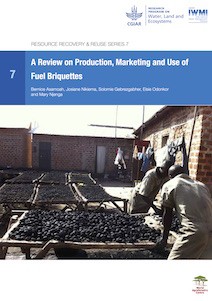
In recent years, briquetting has aroused a great deal of interest because of the opportunity to utilize agricultural residues and the organic fractions of municipal solid waste (MSW) more efciently with a potential reduction in environmental pollution levels. Where modern heating and cooking fuels for domestic, institutional, commercial and industrial use are not readily available, briquettes made from biomass residues could contribute to the sustainable supply of energy. This study reviews the briquette making process, looking at the entire value chain starting from the type and characteristics of feedstock used for briquette making to the potential market for briquettes in developing countries. It also analyzes the role that gender plays in briquette production. Read more
6: Business models for fecal sludge management
On-site sanitation systems, such as septic tanks and pit latrines, are the predominant feature across rural and urban areas in most developing countries. However, their management is one of the most neglected sanitation challenges. While under the Millennium Development Goals (MDGs), the set-up of toilet systems received the most attention, business models for the sanitation service chain, including pit desludging, sludge transport, treatment and disposal or resource recovery, are only emerging. Based on the analysis of over 40 fecal sludge management (FSM) cases from Asia, Africa and Latin America, this report shows opportunities as well as bottlenecks that FSM is facing from an institutional and entrepreneurial perspective. Read on.
5: Potential business opportunities from saline water and salt-affected land resources
Saline water and salt-affected lands suffer from low agricultural productivity and significant environmental constraints. This report presents four case studies on saline water recycling and reuse from developed and developing countries. These examples suggest that strategic investments in salt-affected irrigated zones can make a significant contribution to poverty reduction, generate additional economic benefits and ensure equitable social development for smallholders and marginalized groups, among other advantages. Read on.
4: Global experiences in water reuse
This report reviews a range of drivers, barriers, benefits, and incentives for water reuse and wastewater use outside of the United States; outlines the state of, and geographic variation in, water reuse and wastewater use; and reviews paths for expanding the scale of safe and sustainable water reuse and wastewater use in different contexts as also discussed in the frame of the Sustainable Development Goals (SDGs). Read on.
3: Co-composting of solid waste and fecal sludge for nutrient and organic matter recovery
Proper management of waste and efficient resource recovery are relevant aspects of environmental management systems that could support a circular economy and assist in addressing global challenges. Composting, as a low cost technology, remains a valid and relevant option to enhance waste management in developing countries where the bulk of collected solid waste is organic in nature but recycling rates are still low. This report provides practical guidance and the latest knowledge related to co-composting of organic waste from municipal waste streams, including human excreta, in order to support planners, researchers, development experts and practitioners in their work. Read on.
2: Technological options for safe resource recovery from fecal sludge
Fecal sludge contains important quantities of organic matter and nutrients that are valuable for agricultural production. This document describes technical solutions for the recycling of fecal sludge to benefit agriculture; this is particularly important for developing countries where there is an urgent need to enhance, at low cost, soil fertility for agricultural purposes. Read on.
1: On-farm treatment options for wastewater, greywater and fecal sludge with special reference to West Africa
Where conventional wastewater treatment is lacking, and water in streams and rivers used for crop irrigation is heavily polluted, alternative or additional options for health risk reduction are needed. On-farm treatment, although it can hardly replace conventional treatment, can contribute to risk reduction, especially if combined with other measures such as safe irrigation practices and post-harvest crop washing. Based on experiences in West Africa, this report presents an overview of low-cost wastewater treatment technologies for pathogen removal, which can be adapted for use in urban and peri-urban areas in low-income countries. Read on.

